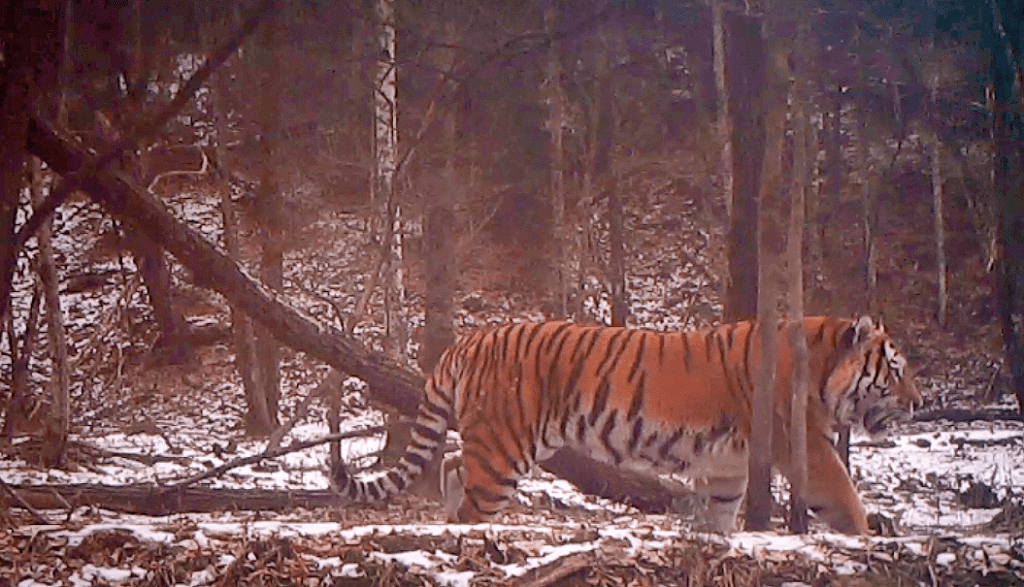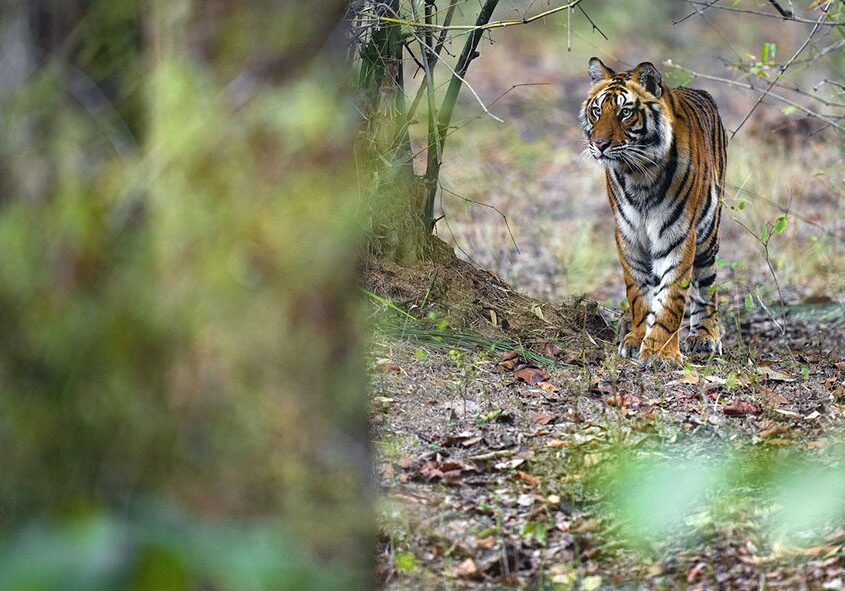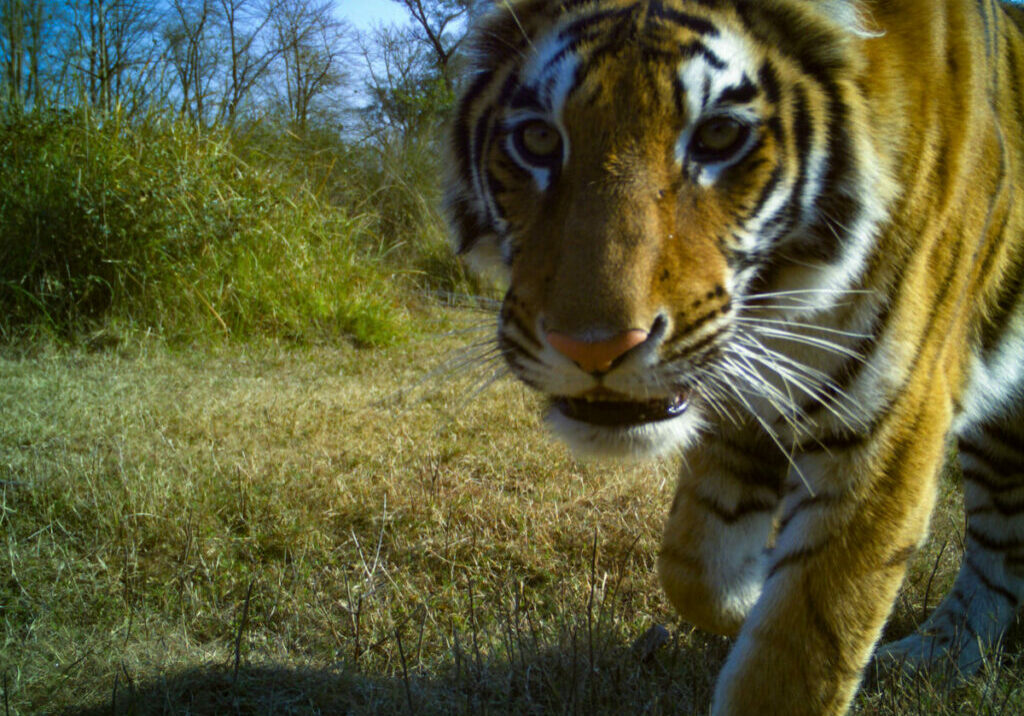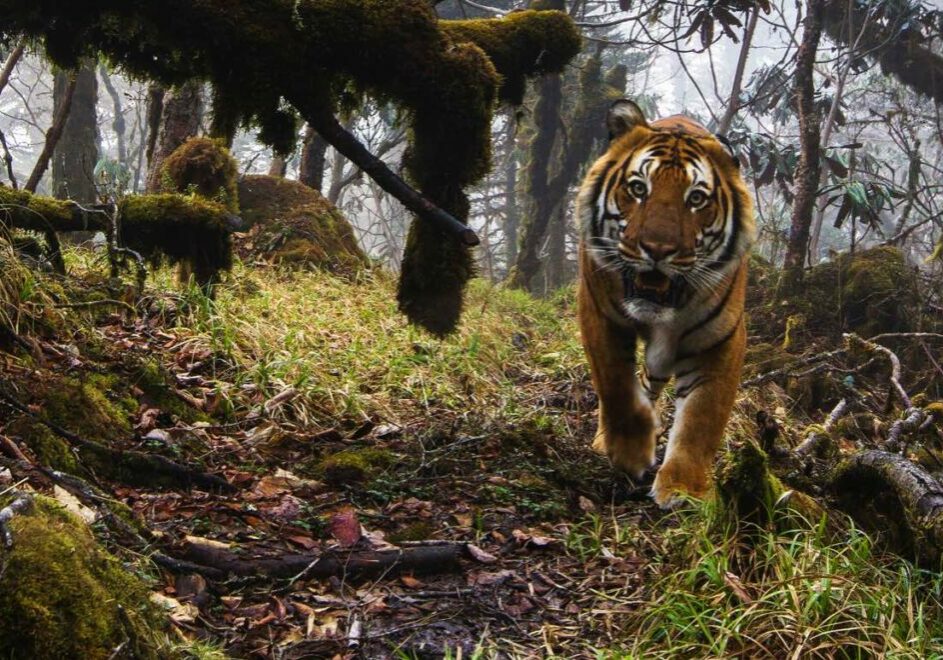
© WWF-CHINA
How did you get into tiger conservation?
I grew up on a farm near mountains and forests in north-east China, the forests I’m now working to protect, so nature has always been close to my life. To follow in my father’s footsteps, as he was also involved in this sector, and to serve the places I feel deeply connected to makes all the hours spent in this field even more worthwhile.
What does an anti-poaching officer do?
Every day on the job looks different. From setting up and maintaining camera traps for tiger monitoring to supporting nature reserves in other ways, such as introducing new management tools and helping to train rangers – my role is multifaceted. Working closely with rangers, who are often first responders in the effort to tackle poaching, is also a core part of my job. Their tireless work in some of the world’s harshest working conditions never fails to inspire me.
How often do you see tigers in China?
Tigers are really deeply ingrained in the culture of China. Even some of the areas in my home town are named after the tiger – my friend found out that these places are part of the historical tiger range. Tigers symbolise power, wealth and health. In China, you can see that people like to wear clothing and fashion accessories that have tiger symbols. Sadly, this symbolism has also led to widespread poaching of tigers for their parts and products, which makes my work as an anti-poaching officer that much more important.
What sort of attitude do people have towards wild tigers where you live?
The tiger is sometimes seen as a monster. In my grandfather’s generation, they needed to go to the forest to collect timber and many people didn’t have much protection, so they were really afraid of tigers. Back then, tigers sometimes attacked locals, so they would stay away from tigers or kill them.
But when people realised that the tigers were gone, it also became really hard. In my generation, we don’t have tigers in my home town any more. Now wild boar and deer go to farms and eat the crops, so it’s hard for the local people – they realise the tigers were actually also protecting the area.

© JILIN HUANGNIHE NATIONAL NATURE RESERVE
What’s one moment in the ‘TX2’ tiger recovery period between 2010-2022 that stands out for you?
In 2010, there were only around 20 wild tigers in China and we had little hope that tigers were even breeding within the country. That was until 2014, when camera traps recorded a tigress and her playful cubs in the Wangqing-Hunchun-Dongning area, 30km from the Russia-China border. This was the first video of a tiger family so deep inside China, which spurred a lot of hope for tiger recovery in inland China. It showed that tigers were breeding in China after nearly being pushed to single digits. In the past, the only evidence of Amur tigers from the border area was through elusive pawprints but here we had a 10-second video of a happy family.
Amur tigers were once found throughout northern China, the Russian Far East and the Korean peninsula. By the 1940s, logging and hunting had driven them to the brink of extinction, with no more than 40 individuals remaining in the wild. Many years of conservation work had helped make it possible for this tiger family to be here, and hopefully many more across China.
And for you personally, what’s been one area of your work in the past 12 years of tiger conservation that’s most significant?
One area of work has been how to improve the welfare of rangers, particularly community rangers. In the past three years, we’ve been collaborating with our partners to improve anti-poaching management by working more closely with a wider range of people.
It’s paying off, we’re seeing tiger numbers continue to slowly rise in China and hopefully this momentum will increase in the decades ahead. Improving rangers’ welfare and capacity will be a major area of focus in the decades ahead.
What’s the situation like for tigers now?
The population of tigers in China is slowly increasing, after many years of sustained conservation, but the situation is still fragile.
From your perspective, how has tiger conservation changed over the past decade?
In the past 10 years, wildlife monitoring technology has rapidly advanced. Before, we relied only on traditional camera-trap monitoring to collect data, but in many places new technology is widening opportunities to better monitor the species and tackle poaching.
In some places in China, universities are piloting integrated ‘air-earth’ monitoring methods using a combination of drones and cameras, allowing teams to conduct real-time monitoring. Artificial-intelligence machine learning is also becoming more widely used to distinguish between types of species recorded on camera traps. In the past, rangers needed to be skilled to recognise and separate all the images, which was very time consuming.
One camera trap can collect 2,000-3,000 images at a time. Rangers would have to go to the location to collect the data, which would take months as they’re in very remote locations. Once they’ve been retrieved, it takes weeks to process the images and identify all the species. So the fact that new technology is speeding up this process means we can work more efficiently to protect tigers from poaching.
Where does tiger conservation in China go from here?
The National Forest and Grassland Bureau has plans for nationwide ranger training across the whole of China. Previously, people were just focused on their own areas, but now we have ways to help improve rangers’ capacity. Rangers are also being trained to use social media – they’re taught what kinds of stories people are interested in so they can work on raising public awareness.
Some groups are also working on bringing new cable technology to China’s forested areas. These cables are placed in key areas where tigers and other large predators often venture. When they step on the cable or even come near it, it sends an alert to neighbouring communities. This technology is now being used in some areas where human-wildlife conflict has been a challenge. Hopefully we’ll see some results soon!
Help us protect tigers
With your support, we can build a better future for tigers. Adopt a tiger today and you can help us continue our vital conservation work
More to explore

Are tigers coming back from the brink?
For decades, we’ve worked tirelessly to secure a future for wild tigers. Now, as we approach a key milestone in tiger conservation, we need your help again

